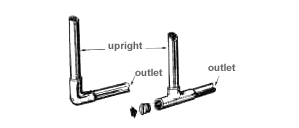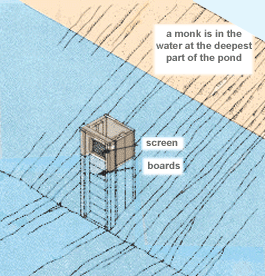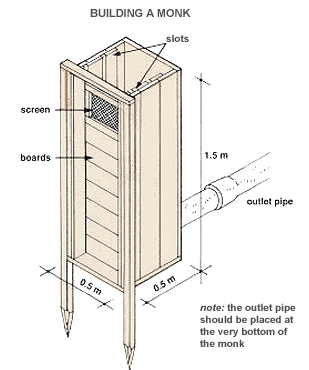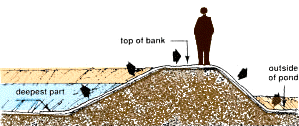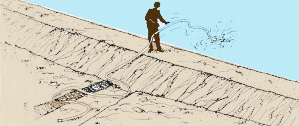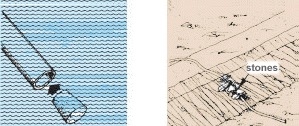5. OUTLETS TO LET WATER OUT OF THE POND
|
(96) You will need an outlet to let water out of your pond when you want to empty it. (97) You should place the outlet at the bottom of the bank at the lower end of your pond at the deepest part. |
|
SIMPLE OUTLETS(98) The outlet can be made from a piece of heavy bamboo or a pipe of plastic or metal. The outlet pipe should be about 10 centimetres in diameter. The bank of your pond is much wider at the lower end than at the upper end, so the outlet pipe will have to be longer than the inlet pipe. |
|
|
| (99) The outlet pipe should be long enough to reach through the bottom of the bank from one side to the other. You will need a pipe about 6.5 metres long to reach through the bank at the lower end of your pond. |
|
(104) Put the outlet pipe in the gap in the bank and rebuild the bank over it. (105) If you use an outlet of about 10 centimetres in diameter, it will take about 10 hours to empty your 400 square metre pond. |
(106) It is easier to place the outlet where you want it to be before you dig out the centre of the pond and build the banks. When you build another pond, you will understand this and you will be able to do it when you are building the banks. But now, when you are building your first pond, you should place the outlet in the way you have just learned because it is easier to understand. |
A BETTER OUTLET(107) If you use a plastic or metal pipe for the outlet of your pond, you can make it better by putting an upright length of pipe on the end of the outlet using an L or a T piece like the ones in the drawing. Close the T piece with a plug as shown. (108) Put the L or T piece and the upright pipe on the end of the outlet outside the pond, but protect it so that it cannot be reached by animals or other people. |
|
|
(109) The top of the upright pipe should reach about 3 to 5 centimetres above the water level of your pond. If the water rises above this level, it will overflow from the upright pipe.
|
(110) Tie the upright pipe to a pole that has been pounded into the ground so that it will not slip down and let the water out of the pond before you want it to.
|
|
|
(111) When you want to let out the water, untie the upright pipe and push it down. The water will then flow out of the pond. (112) There is still another way to let water out of your pond, using a siphon. You will learn how to use a siphon in items 122 to 133. |
|
ANOTHER KIND OF OUTLET: THE MONK(113) You can build another kind of outlet to empty a bigger pond faster. It is built inside the bank at the deep end of the pond. This kind of outlet is called a monk. When the pond is filled, the monk will be in the water.
(117) A monk also serves as an overflow, so you will not need to have an overflow pipe like the one shown in items 169-179. (118) You can build a monk from wood, or if you know how to build with bricks or blocks, you can use these. (119) The drawings below show you how to build a monk using wood, and how to fill and empty a pond using a monk. |
(114) A monk is a tall box with two sides, a back, a front formed by wooden boards and a bottom. Each side has two slots to hold two rows of wooden boards. (115) Boards are put into the slots to keep water in the pond or taken out to let water out. (116) A monk has a screen that fits on top of the first row of boards. It keeps your fish from getting out when the pond is too full or when you are emptying it.
|
|
|
|
IMPROVING YOUR PIPE OUTLET(120) You can further improve a pipe outlet by placing a collar of cement around the centre of the pipe. The collar will hold the pipe in place in the bank and keep water from seeping through the bank outside the pipe. |
|
|
(121) The following drawings show you how to build a wooden form to make a cement collar.
|
|
USING A SIPHON TO DRAIN YOUR POND(122) You will also be able to use a siphon to empty your pond. If you use a siphon, you will not need an outlet but you will need an overflow like the one described in items 172 to 179. (123) A siphon is a simple tube that runs from the inside of the pond over the bank and lies on the ground outside the pond. . |
|
|
|
(124) A siphon can be made of plastic or rubber tubing at least 3 centimetres in diameter (125) The siphon must be long enough to reach from the deepest part of the pond and run over the top of the bank and down the outside of the bank. You will need a siphon about 8 metres long to reach over the top of the bank from the deep part to the outside. |
|
(126) When you are ready to empty your pond, put all of the siphon into the pond. It will fill with water. Be sure the tube is full of water from one end to the other. If the siphon is not full of water, it will not work.
|
(127) While the siphon is still in the water, close one end of the tube with a plug and leave the other end open.
|
|
|
(128) Leave the open end of the siphon below the surface of the water. You can use stones to hold the siphon under the water, but be sure that they are not so heavy that the water will be shut off. |
(129) Take the other end of the siphon, which is closed with the plug. Lift it over the top of the bank and put it on the ground outside the pond. |
|
(130) If the ground on the outside of the pond is higher than the
pond bottom at the deepest part, you will have to dig a ditch so
that the end of the siphon on the outside of the pond will be lower
than the end of the siphon in the pond. The ditch will also take
the water away when you empty your pond. |
 |
|
(131) Now, take the plug out of the siphon. If the end on the outside is lower than the end in the pond and if the end in the pond is under water, water will start to flow through the tube and out of your pond. |
|
|
(132) If the end of the siphon in the pond comes to the surface, the water may stop flowing. If this happens, put the whole siphon into the pond to fill it with water and begin again. |
(133) It will take a lot more time to empty a pond with a siphon than with an outlet. If you use a siphon of about 3 centimetres in diameter, it will take about three days to empty your pond. |
Summary
YOU HAVE LEARNED HOW TO DRAIN WATER OUT OF EACH POND
Provide an outlet for each pond:
- locate it through the bottom of the lower-end bank
- make its bottom about 10 cm below the deepest point in the pond
- use a straight pipe, an L-pipe or a monk
Or use a siphon made from a flexible tube at least 3 cm in diameter





